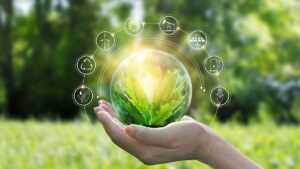Introduction: Merging Innovation with Responsibility
In the modern age, technology stands at the forefront of every major transformation shaping the global landscape. From healthcare to education, agriculture to energy, and transportation to finance, technology has revolutionized the way societies function. However, the 21st century has presented humanity with one of its greatest challenges yet: ensuring sustainable development. As climate change accelerates, natural resources dwindle, and socioeconomic inequalities persist, the role of technology in achieving sustainable development has become not only significant but indispensable. This article explores the intricate ways in which technological advancements contribute to sustainable development goals (SDGs), highlighting both their potential and the caution needed to ensure inclusive and lasting progress.
Defining Sustainable Development and Its Global Relevance
Sustainable development is broadly defined as development that meets the needs of the present without compromising the ability of future generations to meet their own needs. This concept, rooted in environmental consciousness and social equity, was formalized through the United Nations’ 2030 Agenda for Sustainable Development, which established 17 Sustainable Development Goals (SDGs). These goals aim to eradicate poverty, ensure quality education, achieve gender equality, foster economic growth, combat climate change, and promote responsible consumption and production, among other objectives.
Each of these goals requires a strategic blend of policy, human capital, and innovation. This is where technology becomes pivotal. From digital solutions that provide access to education and health services to clean energy innovations that reduce carbon emissions, technology has emerged as the linchpin of sustainable development. However, its application must be thoughtful, inclusive, and adaptable to diverse socio-economic conditions.
Technology as an Enabler of Environmental Sustainability
One of the most pressing concerns in the sustainability discourse is environmental degradation. Climate change, deforestation, water scarcity, and pollution threaten the planet’s ecosystems and the livelihoods of billions. Technological innovation offers concrete solutions to mitigate these challenges and transition toward more sustainable practices.
Renewable energy technologies, such as solar, wind, hydro, and geothermal power, have significantly reduced reliance on fossil fuels. Smart grids and energy storage solutions allow for efficient distribution and usage, ensuring that energy consumption aligns more closely with renewable generation. In agriculture, precision farming technologies help farmers reduce pesticide use and water waste by using data analytics and IoT (Internet of Things) sensors to monitor soil conditions and crop health in real-time.
In urban development, technology plays a vital role in the emergence of smart cities. These cities utilize big data, AI, and automation to manage resources like electricity, water, and transportation efficiently. Sensors integrated into infrastructure can monitor air quality, control traffic flow, and alert municipal services to issues such as water leaks or road damage, thus minimizing waste and optimizing maintenance. These innovations, when scaled appropriately, contribute significantly to the reduction of carbon emissions and promote resource-efficient living.
Bridging Social Gaps Through Digital Inclusion
Beyond the environment, sustainable development necessitates social inclusion and equitable access to resources. Technology has become a powerful tool in bridging socioeconomic gaps, especially in areas such as education, healthcare, and financial services.
E-learning platforms have revolutionized access to education. In remote regions where qualified teachers and educational infrastructure are scarce, digital learning tools and internet connectivity can provide children and adults alike with opportunities for learning and skill development. Open-source content, language translation technologies, and mobile learning apps ensure that educational resources are accessible even in marginalized communities.
In healthcare, telemedicine and mobile health applications allow people in underserved or rural areas to consult with doctors, receive medical advice, and even undergo diagnostic tests remotely. This has proved particularly valuable during the COVID-19 pandemic, when traditional healthcare systems were overwhelmed. Furthermore, AI-driven analytics can assist in early disease detection and public health monitoring, improving both the efficiency and the reach of healthcare services.
The financial sector has also been transformed by technology through innovations like mobile banking, digital wallets, and blockchain. These tools provide unbanked populations with access to financial systems, empowering individuals to save money, secure loans, and engage in economic activities that were previously inaccessible to them. In this way, technology contributes directly to poverty alleviation and economic inclusion.
Supporting Economic Growth and Sustainable Industry
Technological advancement is closely tied to economic progress. However, traditional models of economic growth often overlooked environmental and social costs. Sustainable development requires that economic activities not only generate wealth but do so in a way that does not exploit the planet or its people. Here, technology offers a way forward by enabling more sustainable industrial practices and fostering innovation-driven entrepreneurship.
The advent of the Fourth Industrial Revolution—characterized by technologies such as artificial intelligence, robotics, biotechnology, and 3D printing—has created opportunities for cleaner production methods, waste reduction, and sustainable supply chains. For instance, industries can use AI to forecast demand and reduce overproduction, or adopt additive manufacturing (3D printing) to minimize material waste.
Moreover, circular economy models are increasingly being implemented with the help of technology. These models promote reuse, recycling, and remanufacturing, thus extending the lifecycle of products and reducing the need for raw material extraction. Companies are using blockchain to trace the origin of materials and ensure ethical sourcing, while also enhancing transparency in the supply chain.
Startups and entrepreneurs are leveraging technology to create solutions tailored to local challenges, such as low-cost water purification systems, solar-powered refrigeration units, or digital platforms connecting farmers to markets. These innovations not only drive local economies but also address specific sustainable development targets.
Challenges and Risks of Technological Integration
While the benefits of technology in sustainable development are immense, its adoption is not without challenges. The digital divide remains a significant barrier. Unequal access to internet connectivity, digital devices, and technological literacy can exacerbate existing inequalities, leaving certain populations further behind. For example, while urban centers might benefit from 5G networks and smart infrastructure, rural communities may struggle with basic connectivity.
There are also ethical concerns surrounding data privacy, surveillance, and algorithmic bias. As technology becomes more deeply integrated into daily life and decision-making processes, ensuring that it is used responsibly and transparently is critical. Moreover, the production and disposal of electronic devices contribute to environmental problems, such as e-waste and the unsustainable mining of rare earth materials.
Another concern is that rapid automation and AI deployment could displace jobs, particularly in sectors reliant on manual labor. Although new types of employment will emerge, ensuring a just transition for workers through reskilling and education programs is essential for truly sustainable development.
Policy, Partnerships, and the Way Forward
To fully harness the potential of technology for sustainable development, coordinated efforts are required among governments, the private sector, civil society, and international organizations. Policymakers must create regulatory environments that encourage innovation while protecting the rights of individuals and the environment. Investments in infrastructure, particularly in low-income regions, are necessary to close the digital divide and promote inclusive access.
Public-private partnerships can accelerate the deployment of sustainable technologies, while international cooperation is vital in sharing knowledge, resources, and best practices. Open-source platforms and collaborative research initiatives can democratize access to innovation and ensure that even the least developed countries can benefit from technological progress.
Education systems must also evolve to equip current and future generations with the skills needed in a digital, sustainable economy. Critical thinking, digital literacy, and environmental awareness should be core components of curricula, preparing citizens to engage with technology ethically and productively.
Conclusion: A Future Shaped by Responsible Innovation
The journey toward sustainable development is complex and multifaceted, requiring holistic strategies that balance economic growth, social inclusion, and environmental protection. Technology, when developed and deployed with foresight and equity, serves as one of the most powerful instruments to achieve this balance. Whether it’s through clean energy solutions, digital healthcare, smart agriculture, or inclusive financial tools, technology continues to reshape the boundaries of what is possible.
However, it is imperative that this technological transformation be guided by ethical considerations, inclusive practices, and robust policy frameworks. Only then can the promise of sustainable development be realized—not just for some, but for all. As the world faces the critical decades ahead, technology will remain at the heart of global efforts to build a resilient, fair, and sustainable future.



